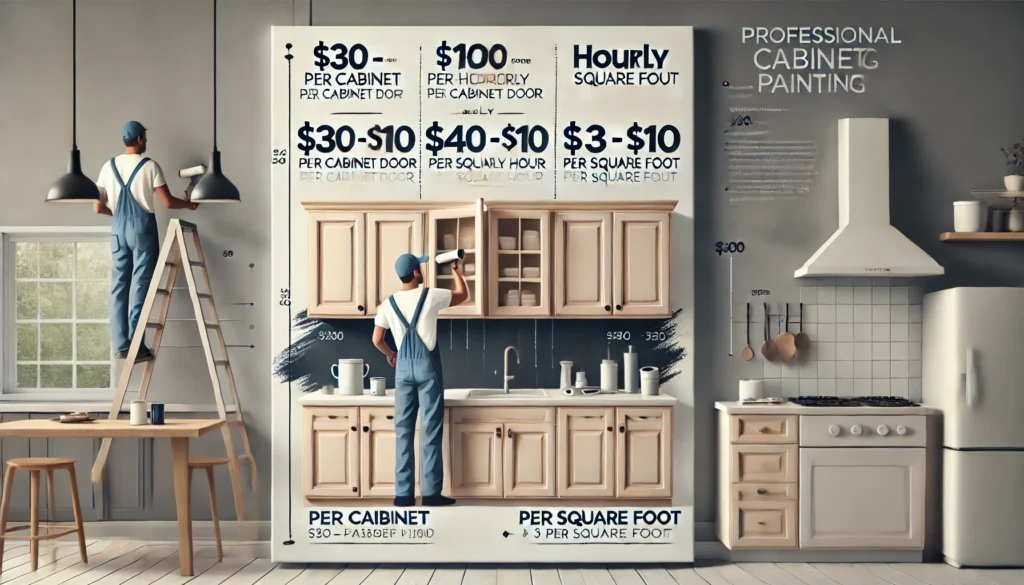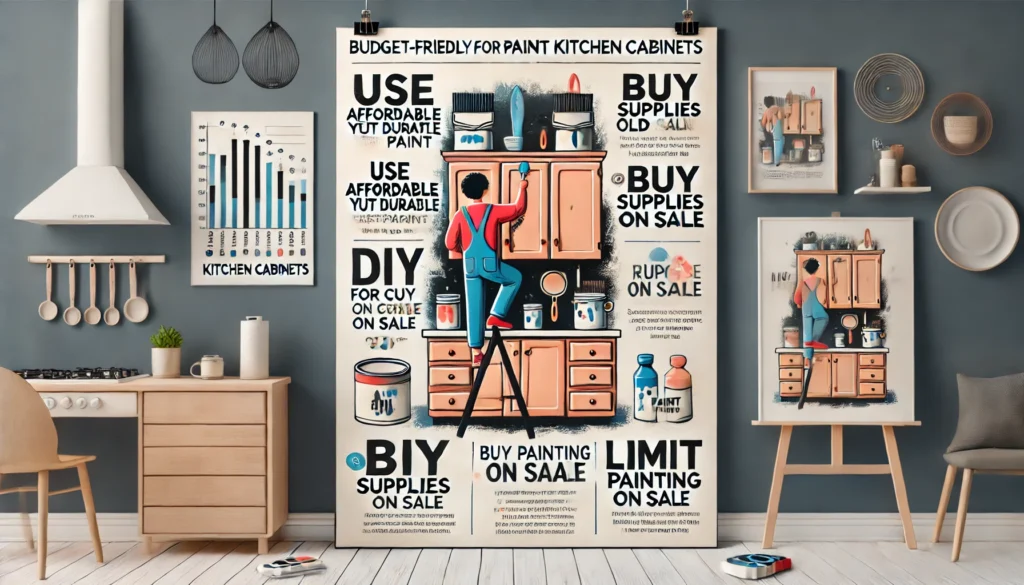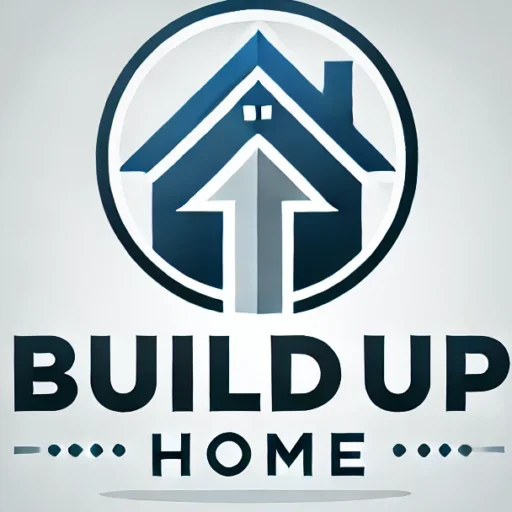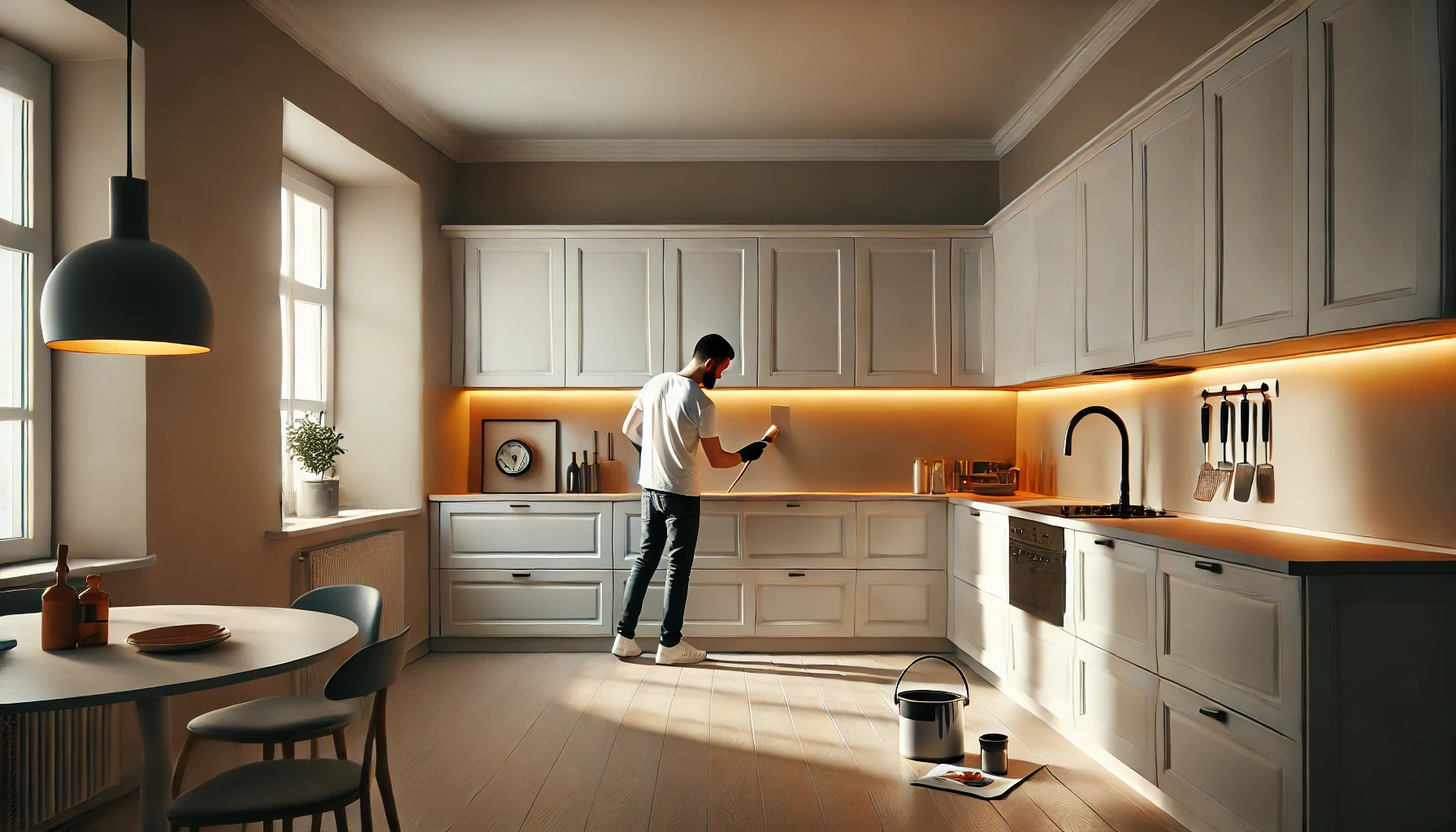A Complete Breakdown of Costs, Factors & DIY vs. Professional Painting
Painting kitchen cabinets is a cost-effective way to give your kitchen a fresh new look without the high expense of a full renovation. Many homeowners choose to paint cabinets instead of replacing them, as it offers a budget-friendly solution while still dramatically improving the kitchen’s aesthetic. However, the cost of painting kitchen cabinets can vary significantly depending on several factors.
The total expense depends on whether you choose to paint the cabinets yourself or hire a professional, the type of paint used, the size and complexity of the cabinets, and additional costs such as primers, protective coatings, and hardware replacements. Understanding these factors can help you create a realistic budget for your project.
On average, DIY cabinet painting costs between $200 and $600, while hiring a professional can range from $1,500 to $5,000 or more, depending on the kitchen size and paint quality. The labor cost for professional painters is a significant part of the budget, but it ensures a flawless finish and saves you time.
In this guide, we’ll explore every aspect of cabinet painting costs, breaking down DIY vs. professional pricing, factors that affect the cost, and a step-by-step process to help you achieve a high-quality paint job. Whether you’re looking to refresh your kitchen for personal satisfaction or increase home value before selling, understanding the financial aspect of painting cabinets is essential for making informed decisions.
Factors That Influence the Cost of Painting Kitchen Cabinets
Before diving into the cost breakdown, it’s essential to understand the factors that affect the total price. Several variables determine how much you’ll spend, including the number of cabinets, the type of paint, and the condition of your existing cabinets. Let’s take a closer look at these key cost factors.
Cabinet Size and Layout
The number of cabinets in your kitchen directly impacts the total cost of painting. Larger kitchens with more cabinets require more paint, more primer, and additional labor, increasing overall expenses.
Another crucial factor is the cabinet layout. Simple flat-front cabinets are easier to paint than intricate designs with raised panels or decorative molding, which require more prep work and precision. If your cabinets have a lot of details, the painter (or you, if doing it DIY) will need to spend extra time sanding, priming, and ensuring that every crevice is covered evenly.
The complexity of your kitchen’s layout also matters. If your cabinets are built into tight corners or have unique angles, it may take longer to complete the painting process. Professional painters may charge extra for difficult-to-reach areas, and DIYers may need additional tools like detail brushes or spray equipment.
Type of Paint & Finish
The type of paint you choose plays a significant role in the total cost. There are two main types of cabinet paints: oil-based and latex-based. Oil-based paints are more durable and provide a smoother finish, but they tend to be more expensive and require longer drying times. Latex paints, on the other hand, are water-based, dry faster, and are easier to clean up, making them a popular choice for DIY projects.
Finish selection also affects pricing. Matte and satin finishes tend to be more affordable, while semi-gloss and high-gloss finishes cost more but offer better durability and are easier to clean. A high-gloss finish reflects light well and provides a sleek, modern look but requires a flawless application to avoid visible brush strokes.
Premium paints from brands like Benjamin Moore or Sherwin-Williams tend to be pricier than budget options, but they often last longer and require fewer coats. Investing in high-quality paint may save money in the long run by reducing the need for frequent touch-ups.
Condition of Existing Cabinets
The condition of your cabinets before painting can affect the amount of prep work needed. If your cabinets have scratches, dents, or peeling surfaces, they will need to be repaired before painting. This can increase both material costs (wood filler, sandpaper, etc.) and labor costs if you’re hiring a professional.
Grease and grime buildup are also common issues in kitchens, especially on cabinets near the stove. Proper cleaning and degreasing are necessary before applying paint, and skipping this step can result in poor adhesion.
If your cabinets are heavily damaged or made of laminate instead of solid wood, painting might not be the best long-term solution. In such cases, resurfacing or replacing them could be a better investment.
DIY vs. Professional Painting
One of the biggest decisions homeowners face is whether to paint their cabinets themselves or hire a professional. Each option has its advantages and drawbacks.
- DIY Painting: This is the cheaper route, costing between $200 and $600 depending on the materials used. However, DIY painting requires time, patience, and skill to achieve a professional-looking finish.
- Professional Painting: Hiring a pro ensures a flawless finish, but it comes at a higher cost—typically $1,500 to $5,000. Professional painters have the experience, tools, and techniques to deliver long-lasting results.
DIY is a great option for those with experience in home improvement projects, while professional painting is ideal for homeowners who want a high-quality finish with minimal effort.
Labor Costs for Professional Painting

Labor costs for painting kitchen cabinets vary based on location, experience level, and project complexity. Some professionals charge per cabinet, while others charge per square foot or hourly rates.
- Per cabinet pricing: Typically ranges from $30 to $100 per cabinet door
- Hourly rates: Most painters charge between $40 and $100 per hour
- Per square foot pricing: Costs range from $3 to $10 per square foot
If you choose to have your cabinets professionally painted in a spray booth, expect to pay more than on-site painting. Spraying creates a factory-like finish but requires the cabinets to be removed and transported to a shop.
Additional Costs
Apart from paint and labor, other expenses can increase the overall cost of your cabinet painting project:
- Hardware replacement: If you want to update your kitchen’s look, replacing knobs, handles, and hinges can cost $2 to $20 per piece
- Primer & sealants: Essential for durability, costing between $20 to $50 per gallon
- Protective coatings: Adding a protective layer to extend the paint’s lifespan can cost $50 to $100
Factoring in these additional costs ensures a realistic budget for your project.
How Much Does It Cost to Paint Kitchen Cabinets? (Price Breakdown)
Understanding the costs involved in painting kitchen cabinets helps homeowners plan their budget effectively. Whether you opt for a DIY project or hire a professional, it’s important to break down the total expenses into different components.
The cost of painting kitchen cabinets varies based on factors such as paint quality, labor, materials, and additional enhancements like protective coatings or new hardware. Below, we’ll explore the estimated costs for both DIY painting and professional cabinet painting, helping you decide which option suits your budget and skill level.
DIY Painting Cost Estimate
For homeowners who prefer a hands-on approach, DIY cabinet painting is an affordable way to refresh the kitchen. Below is a cost breakdown for a standard DIY project:
- Paint: A gallon of high-quality cabinet paint costs between $30 and $80. Most kitchens require one to two gallons depending on cabinet size and the number of coats needed.
- Primer: A good primer enhances paint adhesion and durability. Expect to pay $20 to $50 per gallon.
- Brushes and Rollers: High-quality brushes and foam rollers for a smooth finish cost $10 to $50.
- Sandpaper and Degreasers: Sandpaper (for smoothing surfaces) and degreasers (for cleaning cabinets) cost around $10 to $30.
- Protective Topcoat: If you want extra durability, a clear protective sealant will add $20 to $50 to your cost.
Total DIY cost: $200 – $600, depending on the size of your kitchen and the materials you choose.
Professional Painting Cost Estimate
Hiring a professional ensures a flawless finish, but it comes at a higher cost. Here’s a breakdown of what to expect:
- Labor Costs: Professional painters charge between $40 to $100 per hour.
- Paint and Supplies: Most professionals include paint and materials in their total price, but high-end projects with premium paints may increase costs.
- Total Cost by Kitchen Size:
- Small kitchens (100-150 sq. ft.): $1,500 – $3,000
- Medium kitchens (150-250 sq. ft.): $2,500 – $4,000
- Large kitchens (250+ sq. ft.): $4,000 – $6,000+
Professional cabinet painting is an excellent choice for homeowners who want a high-quality, long-lasting result without the hassle of doing it themselves.
Step-by-Step Guide to Painting Kitchen Cabinets
For those choosing the DIY route, following a structured step-by-step approach ensures a professional-looking finish. Below is a detailed guide to painting kitchen cabinets.
Step 1: Preparation
Proper preparation is crucial for achieving a durable and smooth paint job. Before starting, gather all necessary tools and materials.
- Remove Cabinet Doors and Hardware
- Label each cabinet door and drawer to ensure correct reinstallation.
- Use a screwdriver to remove hinges, handles, and knobs.
- Clean and Degrease Surfaces
- Kitchen cabinets accumulate grease and grime over time.
- Use a degreaser or mild dish soap to clean all surfaces thoroughly.
- Repair Dents, Scratches, or Holes
- Use wood filler to repair any imperfections.
- Allow it to dry before sanding the surface smooth.
Taking time to prepare the cabinets properly will result in a more even and professional-looking finish.
Step 2: Sanding and Priming
Sanding and priming create a smooth base for the paint to adhere to, ensuring long-lasting results.
- Importance of Sanding
- Sanding helps remove old paint, smooth out imperfections, and improve paint adhesion.
- Use 120- to 220-grit sandpaper to lightly scuff the cabinet surface.
- Choosing the Right Primer
- Oil-based primers offer excellent durability but require more drying time.
- Latex primers are easier to use and dry faster but may need additional coats.
- Drying Time Considerations
- Allow the primer to dry completely before applying paint.
- Follow the manufacturer’s recommendations for drying time, usually 4 to 24 hours.
Skipping sanding or priming can lead to peeling or uneven paint application, so take your time during this step.
Step 3: Painting the Cabinets
Once the cabinets are primed, it’s time to apply the paint. Choosing the right technique can make a big difference in the final outcome.
- Best Techniques for Applying Paint
- Brushing and rolling: Best for beginners, but may leave brush strokes.
- Spraying: Creates a smooth, factory-like finish but requires more prep work.
- Number of Coats Needed
- Apply at least two coats of paint for even coverage.
- Let each coat dry before applying the next one.
- Drying and Curing Time
- Cabinets may feel dry to the touch in 4-6 hours, but full curing takes 7-14 days.
- Avoid heavy use of cabinets until the paint has fully cured.
Taking your time with even, thin coats will lead to a more polished and professional finish.
Step 4: Reassembling the Cabinets
Once the paint has dried, it’s time to put everything back together.
- Reinstalling Doors and Hardware
- Use the labeled doors to ensure everything goes back in the right place.
- Tighten all screws and check alignment before finalizing.
- Adding a Protective Topcoat
- A polyurethane or polycrylic topcoat adds durability and protects against scratches.
- Use a high-quality brush or sprayer to apply a thin, even layer.
Proper reassembly ensures the cabinets function well while maintaining their new look.
Tips for Reducing Costs Without Compromising Quality

Even if you’re on a budget, you can achieve a professional-looking result with these cost-saving tips:
- Choose Budget-Friendly Yet High-Quality Paint: Some mid-range paints perform just as well as high-end options.
- Buy Supplies in Bulk: Purchasing larger quantities of paint, primer, and sandpaper can save money.
- Repurpose Old Hardware: Instead of buying new knobs and handles, consider repainting or refinishing your existing hardware.
- Refinish Only Visible Cabinet Surfaces: If the inside of your cabinets is in good condition, focus only on the exterior to save on materials and labor.
By being strategic with your choices, you can minimize costs without sacrificing quality.
Conclusion About how much does it cost to paint kitchen cabinets?
Painting kitchen cabinets is one of the most cost-effective ways to update a kitchen’s look without a full renovation. The total cost varies depending on whether you choose DIY or professional painting, the type of paint and finish, and the size and condition of your cabinets.
DIY cabinet painting can cost as little as $200 to $600, while professional services range from $1,500 to $5,000 or more. Each option has its benefits, with DIY being more affordable and professional painting offering superior durability and finish.
By following a structured step-by-step process, homeowners can achieve a high-quality result. Additionally, using cost-saving techniques such as repurposing hardware and choosing mid-range paints can help reduce expenses.
No matter which approach you take, planning and preparation are key to achieving the best possible outcome. Whether refreshing your kitchen for personal satisfaction or preparing to sell your home, a well-executed paint job can add value and beauty to your space.

